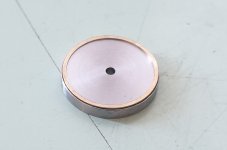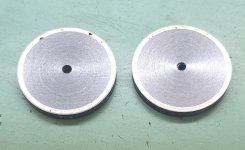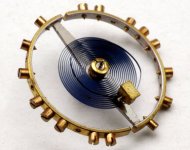Screwmachine
Titanium
- Joined
- Mar 8, 2001
- Location
- Switzerland
I need to make a bimetallic balance wheel (this is watchmaking stuff), but there's very little info out there. I have one text that in a paragraph explains the process, cut groove in steel blank, make brass ring to fit and stand a bit high, "coat groove, ring, and the rest with borax mixed with clean water", then heat until the brass melts.
I have tried borax and boric acid, heating with a torch (propane, large, don't have oxy acetelyne or other), and heating in a oven that reaches a high enough temp. So far boric acid and torch have given the best results, oven (surprisingly) the worst. Borax seems a little less good than boric acid. I do have some black brazing flux from Carbide Processors which has some promising sounding nasty stuff in it, but it has dried out; I can grind it in a mortar remix with, water?
The steel is a standard steel used here, not too different from O1 (no lead, easy heat treat). The only brass I can get a hold of is similar to 360, which contains lead, so I'm wondering if that could be an issue. Anyone with any experience here? It has to be fused, brass melted, brazing is out as the whole thing gets reheated after machining to heat treat the steel. About 10 tries in- worst part is cutting the 0.6mm x 2.20mm deep groove, haha. Total diameter of the blank is 16mm.
I have tried borax and boric acid, heating with a torch (propane, large, don't have oxy acetelyne or other), and heating in a oven that reaches a high enough temp. So far boric acid and torch have given the best results, oven (surprisingly) the worst. Borax seems a little less good than boric acid. I do have some black brazing flux from Carbide Processors which has some promising sounding nasty stuff in it, but it has dried out; I can grind it in a mortar remix with, water?
The steel is a standard steel used here, not too different from O1 (no lead, easy heat treat). The only brass I can get a hold of is similar to 360, which contains lead, so I'm wondering if that could be an issue. Anyone with any experience here? It has to be fused, brass melted, brazing is out as the whole thing gets reheated after machining to heat treat the steel. About 10 tries in- worst part is cutting the 0.6mm x 2.20mm deep groove, haha. Total diameter of the blank is 16mm.







